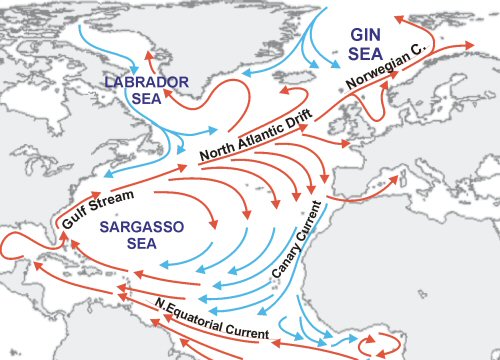
The Gulf Stream current system. We North-West Europeans usually say that the Gulf Stream warms our shores, but to ocean scientists (and North Americans) the Gulf Stream is only the fast, warm, western boundary current that flows northwards past the US seaboard. The broader, slower flow that leaves the shores of America and heads across the Atlantic for Europe is the North Atlantic Drift Current. A branch of this flow turns back southwards along the coast of Africa as the Canary Current - a cool, eastern boundary current that completes the North Atlantic ocean gyre. However, a second branch of the North Atlantic Drift flows northwards along the west coast of Ireland and Scotland heading for Norway, where it becomes the Norwegian Current. Ultimately this warm current continues into the Barents Sea and also into the Arctic Ocean west of Svalbard, where it becomes the West Spitsbergen Current.
All along this route the Gulf Stream water releases heat and moisture to the atmosphere, making the climate of the region it passes through warmer and wetter than it would otherwise have been. It is the reason why you may see palm trees in west Scotland and potato field near North Cape, at latitudes which otherwise would be frozen for considerable parts of the year.
Along the way the water cools; by the time it reaches the Arctic it may be no warmer than about 4-5 °C. The Sargasso Sea, where much of the Gulf Stream comes from, is saltier than the rest of the Atlantic because of strong evaporation under clear, subtropical skies. On the journey north rain makes it gradually fresher. However, the Gulf Stream water may still be recognized, even in the Arctic, because it is warmer and saltier that other water types surrounding it.